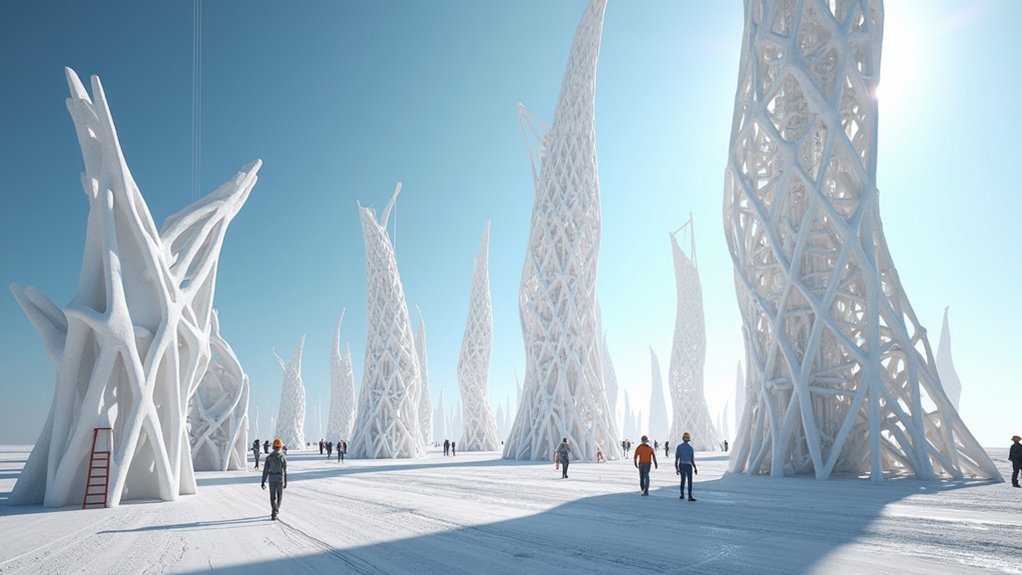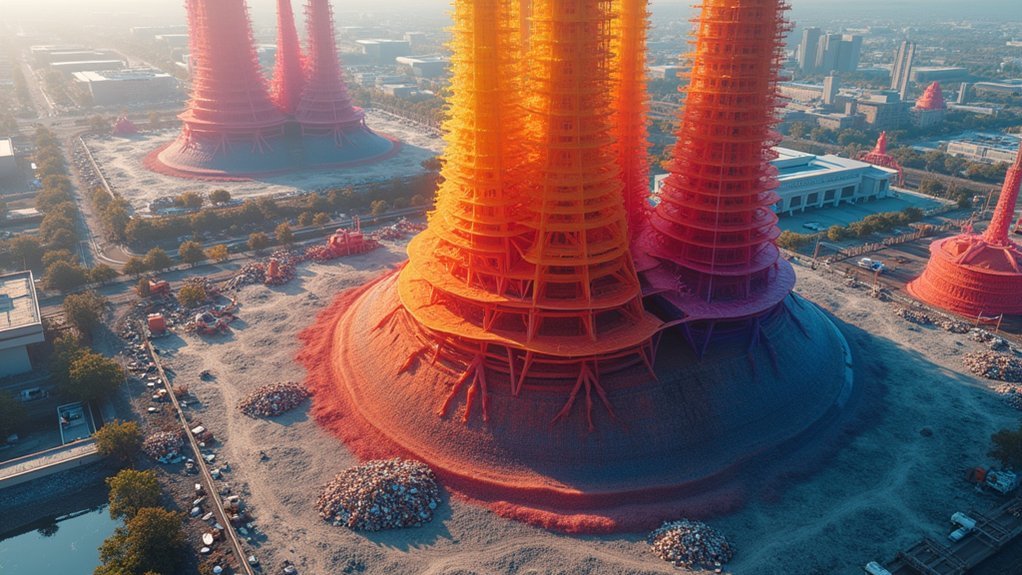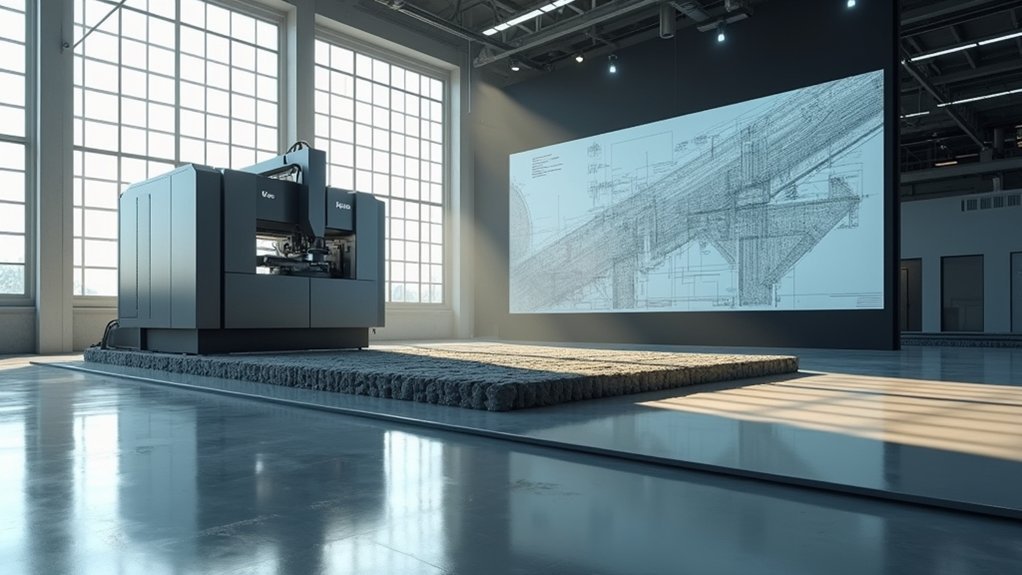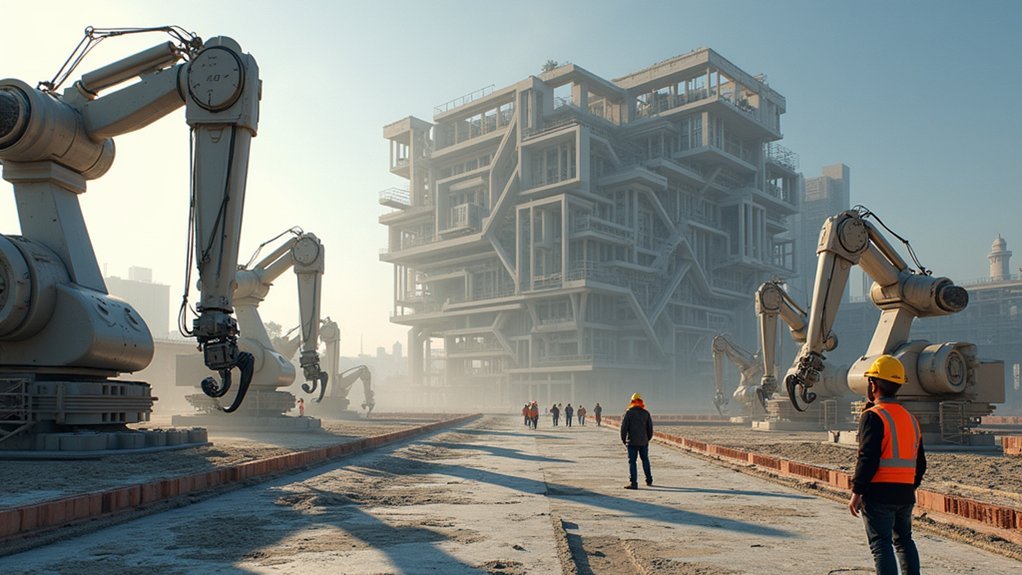You’ll achieve unprecedented design freedom with industrial-scale additive manufacturing, creating complex curves and organic shapes impossible through traditional methods. This technology reduces construction time from months to hours while cutting material waste by 30-60% through precise, layer-by-layer fabrication. Automated robotic systems minimize labor costs and human error, while advanced quality control guarantees exceptional precision. You’ll also benefit from streamlined project management through BIM integration and gain competitive advantages in the rapidly growing market that’s projected to expand at 111.3% CAGR through 2030, positioning your business for transformative opportunities ahead.
Unprecedented Design Freedom and Complex Geometries

While traditional construction methods constrain architects to basic geometric forms, industrial scale additive manufacturing liberates you from these limitations, enabling the creation of complex curves, intricate lattice structures, and organic shapes that were previously impossible to build.
Industrial additive manufacturing breaks free from geometric constraints, empowering architects to construct previously impossible complex curves and organic architectural forms.
This additive technology grants unprecedented design freedom, allowing you to realize your most ambitious architectural visions without compromise.
You can now fabricate amorphous and eccentric geometries using advanced CAD technologies, transforming digital concepts into physical structures with remarkable precision.
The process eliminates traditional manufacturing constraints, empowering you to explore innovative structural possibilities that push creative boundaries.
Whether you’re designing parametric facades, bio-inspired forms, or mathematically complex surfaces, industrial-scale 3D printing makes the impossible achievable, revolutionizing how you approach architectural design and construction.
Significant Reduction in Construction Time and Labor Costs
Beyond the creative possibilities, industrial scale additive manufacturing delivers dramatic improvements in construction efficiency and cost-effectiveness.
You’ll complete large building components in hours rather than weeks or months with traditional methods. Large-Scale Additive Manufacturing automates production through robotic arms and gantry systems, dramatically reducing your labor requirements while minimizing human error risks on construction sites.
You’ll adapt to last-minute design changes quickly, eliminating project delays that typically plague conventional construction. The streamlined 3D printing process cuts material waste by 30-60%, directly reducing your project costs while enhancing sustainability practices.
With the global 3D printing construction market projected to grow at 111.3% CAGR through 2030, you’re positioning yourself ahead of an inevitable industry transformation toward more efficient, cost-effective building methods.
Enhanced Material Efficiency and Waste Minimization

As traditional construction methods generate approximately 100 billion tonnes of raw material waste annually, industrial scale additive manufacturing transforms this inefficiency through precise material layering that uses only the exact amount needed for each component.
You’ll achieve exceptional material efficiency by eliminating surplus materials that typically end up as waste in conventional building processes.
This additive approach enables you to incorporate recycled materials like plastics and concrete, promoting circular economy principles while maintaining structural quality.
You’ll also benefit from producing large-scale components as single pieces, reducing joints and connections that consume additional materials.
This waste minimization strategy supports your sustainability goals by decreasing carbon footprints through reduced raw material extraction and processing, directly contributing to global decarbonization efforts.
Seamless Integration With Building Information Modeling Systems
When you integrate Building Information Modeling systems with industrial-scale additive manufacturing, you’ll create a digital twin that coordinates every aspect of your construction project from structural frameworks to electrical and plumbing installations.
This integration automatically generates optimized print paths for wall systems, streamlining your entire construction workflow and boosting efficiency.
You’ll manage time-sensitive processes more effectively by merging 3D models with 4D sequencing information, ensuring your construction timeline stays on track.
The advanced BIM workflows enable you to customize and prefabricate building components that meet your specific project requirements and client specifications.
Advanced BIM workflows unlock customized prefabrication capabilities, delivering building components precisely tailored to your unique project requirements and specifications.
Most importantly, you’ll experience enhanced collaboration among all stakeholders, reducing errors while maintaining design adaptability throughout the additive manufacturing process.
Superior Quality Control Through Digital Precision

You’ll achieve unprecedented accuracy in construction through digital model precision that translates complex geometries into flawless physical structures.
Your automated quality monitoring systems continuously track every layer of the printing process, catching deviations before they become costly defects.
You can prevent structural issues entirely by implementing real-time defect prevention systems that adjust parameters instantly when anomalies are detected.
Digital Model Accuracy
Digital model accuracy forms the foundation of successful industrial-scale additive manufacturing construction, where even minor discrepancies can translate into catastrophic structural failures or costly material waste. You’ll need meticulously analyzed digital models to identify hazards and structural deficiencies before construction begins. These accurate representations directly impact your 3D printing feasibility and efficiency.
| Accuracy Factor | Traditional Methods | Digital AM Construction |
|---|---|---|
| Geometric Precision | ±10-50mm tolerances | ±1-5mm tolerances |
| Error Detection | Post-construction discovery | Pre-print identification |
| Material Optimization | Manual calculations | Automated algorithms |
| Quality Verification | Physical inspection only | Digital simulation + physical |
Your construction components benefit from Building Information Modeling integration, which enhances digital model precision through numerical simulations. Advanced CAD software generates complex geometries with high fidelity, while automated print path generation guarantees precise material application across every layer.
Automated Quality Monitoring
Building on precise digital models, automated quality monitoring systems transform raw data into actionable insights that prevent construction defects before they occur.
You’ll benefit from sophisticated digital systems that integrate seamlessly with Building Information Modeling workflows, collecting real-time data throughout your additive manufacturing process. This integration allows immediate adjustments to maintain consistently high standards.
Your construction projects gain superior precision through automated inspection tools like 3D scanners and sensors that verify every material layer meets specified tolerances.
This continuous monitoring guarantees structural integrity while enabling complex geometries that traditional methods can’t achieve.
You’ll also reduce waste considerably by identifying defects early, leading to more sustainable practices and lower production costs for your industrial-scale construction projects.
Defect Prevention Systems
While traditional construction relies heavily on reactive quality control measures, defect prevention systems in industrial additive manufacturing take a proactive approach that stops problems at their source.
You’ll benefit from advanced Building Information Modeling (BIM) that integrates design and construction processes, enabling real-time monitoring and simulation of potential structural deficiencies before printing begins. This digital precision allows you to create complex geometries and customized components that meet strict design specifications, ensuring superior structural integrity.
Automated systems minimize human error—a common cause of defects in conventional construction—delivering consistent component quality.
Regular maintenance and calibration of your 3D printing equipment keeps printers operating within ideal parameters, further enhancing reliability. These defect prevention systems guarantee higher quality control standards than traditional methods can achieve.
Sustainable Construction Practices and Environmental Benefits
As environmental concerns reshape the construction industry, industrial scale additive manufacturing emerges as a transformative solution that dramatically reduces material waste through its precise, layer-by-layer approach. You’ll find that traditional construction methods generate approximately 100 billion tonnes of raw material waste annually, while AM’s precision eliminates excess materials.
| Traditional Construction | Additive Manufacturing |
|---|---|
| High material waste | Minimal waste generation |
| Limited recyclability | Enhanced circular economy |
| High transportation costs | Local material utilization |
| Energy-intensive processes | Streamlined operations |
You can utilize recyclable materials like recycled plastics and concrete, fostering sustainable construction practices. By sourcing materials locally, you’ll reduce transportation distances and lower your project’s environmental impact. AM’s innovations include fully recyclable, biologically based multi-story floor panels, demonstrating the technology’s commitment to reducing the construction sector’s significant CO2 emissions.
Customization Capabilities for Client-Specific Requirements
Beyond traditional construction’s rigid constraints, industrial scale additive manufacturing revolutionizes how you can deliver personalized building solutions that precisely match your clients’ unique visions and requirements.
You’ll harness advanced CAD technology to create complex geometries that conventional methods can’t replicate, offering unlimited design flexibility. The customization capabilities enable you to produce tailored building components for specific site conditions and architectural preferences while maintaining structural integrity.
You can rapidly iterate designs using digital models, making real-time adjustments based on client feedback and dramatically shortening project timelines.
Through prefabricated modular components, you’ll accommodate individual aesthetic demands while integrating sustainable materials like recycled plastics and concrete, meeting both client expectations and environmental standards simultaneously.
Advanced Automation and Robotic System Implementation
You’ll find that robotic arm systems revolutionize additive manufacturing by delivering precise material extrusion with multi-axis movement capabilities that surpass traditional fixed-position printers.
Your construction projects benefit from gantry system architecture, which provides large-scale printing capacity and structural stability for fabricating entire building components in single operations.
You’re gaining significant process automation benefits through reduced labor costs, enhanced safety protocols, and streamlined workflows that integrate seamlessly with digital design platforms.
Robotic Arm Systems
When precision meets automation in industrial construction, robotic arm systems transform how you’ll approach large-scale additive manufacturing projects.
These advanced systems deliver intricate designs and complex geometries that traditional methods can’t achieve. You’ll efficiently layer materials like concrete, polymers, and metals, dramatically reducing fabrication time while producing large components in hours instead of days.
Your construction sites become safer as robotic arm automation minimizes human involvement, reducing accident risks associated with manual labor.
The seamless integration of CAD and BIM technologies creates optimized design-to-print workflows, enhancing stakeholder collaboration throughout your projects.
You’ll benefit from exceptional adaptability as these systems handle various materials and techniques, including extrusion and binder jetting, providing the flexibility needed for customized building solutions in today’s demanding construction environment.
Gantry System Architecture
As industrial construction demands greater precision and scale, gantry system architecture emerges as the backbone of large-scale additive manufacturing operations.
You’ll find these automated frameworks traverse defined areas with remarkable accuracy, enabling precise material extrusion with minimal human oversight. When you implement gantry systems, you’re accessing the capability to produce entire walls and roofs as single components, dramatically cutting assembly time and labor expenses.
The advanced automation features you’ll benefit from include multi-task scheduling and rapid adaptation to design modifications without extensive downtime.
You can integrate robotic arms with your gantry systems to handle complex geometries and create customized components that meet modern architectural specifications.
With the 3D printing construction market’s projected 111.3% CAGR through 2030, you’re positioning yourself at the forefront of construction technology evolution.
Process Automation Benefits
Precision becomes paramount when robotic systems take control of your additive manufacturing processes, delivering continuous operation that transforms fabrication timelines from hours to minutes.
You’ll experience reduced material waste and enhanced structural integrity through precise deposition from robotic arms and gantry systems. Automation enables simultaneous task scheduling, streamlining your construction process workflows while minimizing downtimes and optimizing resource utilization.
Your worksite becomes inherently safer with fewer manual interventions required, reducing personnel needs and work-related injuries.
Real-time monitoring capabilities through integrated software platforms guarantee you’ll maintain high-quality outputs while accommodating last-minute design changes efficiently.
This all-encompassing automation framework doesn’t just improve efficiency—it revolutionizes how you approach industrial-scale construction, delivering unprecedented control over your manufacturing environment.
Scalable Solutions for Large Building Components
While traditional construction requires assembling countless smaller pieces, industrial scale additive manufacturing transforms this approach by producing entire building components like walls, roofs, and floors as single, unified structures.
You’ll eliminate complex assembly processes and dramatically reduce labor costs when you adopt this streamlined method.
With robotic arm extruders and gantry systems at your disposal, you can efficiently fabricate modular panels and other large building components that perfectly match your project specifications.
Robotic systems deliver precision-fabricated building components that seamlessly align with your exact project requirements and specifications.
The integration of CAD and Building Information Modeling technology guarantees your 3D printers receive precise design data, optimizing material application for each unique requirement.
You’ll also enhance design flexibility while maintaining structural integrity, allowing for innovative architectural solutions that weren’t possible with conventional construction methods.
Cost-Effective Prefabrication and Modular Assembly
Because additive manufacturing eliminates the need for traditional on-site assembly, you’ll achieve substantial cost reductions through efficient prefabrication processes that produce complete building modules in controlled factory environments.
You can manufacture entire walls and roofs as single pieces, dramatically reducing assembly time and labor expenses. This cost-effective prefabrication approach optimizes material usage while delivering customizable modules tailored to your specific requirements.
Through modular assembly, you’ll benefit from automation that addresses skilled labor shortages and reduces overhead costs associated with hiring and training personnel.
The market’s projected 111.3% CAGR through 2030 reflects this method’s growing adoption. You can also modify designs during printing, enabling efficient responses to last-minute changes that reduce project delays and associated costs.
Innovative Material Applications and Performance Advantages
You’ll discover that industrial-scale additive manufacturing transforms construction through advanced concrete formulations like ultra-high-performance concrete (UHPC), which delivers exceptional strength and durability far beyond traditional materials.
Your projects benefit from sophisticated multi-material integration systems that combine recyclable plastics, geopolymers, and bio-based composites within single print operations.
You’ll achieve enhanced structural performance through complex geometries and customized designs that weren’t possible with conventional construction methods, while dramatically reducing material waste.
Advanced Concrete Formulations
Advanced concrete formulations are revolutionizing industrial-scale additive manufacturing by delivering unprecedented material performance that traditional concrete simply can’t match.
You’ll find that ultra-high-performance concrete (UHPC) and geopolymers enhance strength, durability, and sustainability while incorporating recycled materials to reduce waste. These Construction Technology innovations enable you to create complex geometries and structural components impossible with conventional methods, giving you greater design freedom and customization options.
You’ll considerably reduce construction time and costs since components print as single pieces without additional assembly, minimizing labor and material waste.
Self-healing and lightweight concrete innovations improve your structures’ longevity and resilience, lowering maintenance costs while enhancing performance across various environmental conditions.
Research shows these advanced concrete formulations can decrease your construction project’s overall carbon footprint.
Multi-Material Integration Systems
Building on the enhanced performance capabilities of advanced concrete formulations, multi-material integration systems take industrial additive manufacturing to the next level by seamlessly combining concrete with metals, polymers, and other materials within single construction components. You’ll achieve unprecedented design flexibility while creating structures with varying properties throughout different sections.
| Material Combination | Primary Benefit |
|---|---|
| Concrete + Steel | Enhanced structural strength |
| Concrete + Polymers | Improved thermal insulation |
| Concrete + Recycled plastics | Sustainability advantages |
| Multiple composites | Complex geometries |
These multi-material integration systems enable you to produce customized building components that traditional construction methods can’t achieve. You’ll reduce multiple construction processes while incorporating recycled materials like geopolymers, promoting circular economy practices. The result? Improved mechanical properties, enhanced durability, and reduced long-term maintenance costs for your projects.
Enhanced Structural Performance
While multi-material integration systems expand design possibilities, enhanced structural performance represents the true engineering breakthrough of industrial additive manufacturing.
You’ll achieve enhanced durability through ultra-high-performance concrete and recycled plastics that deliver superior strength compared to traditional materials. Your improved structural designs leverage complex geometries that distribute loads more effectively, creating resilient structures under diverse environmental conditions.
You’ll dramatically reduce material waste by using precisely what’s needed, cutting costs while promoting sustainability.
The technology enables unique performance characteristics like improved thermal insulation and energy efficiency through advanced material integration.
Streamlined Project Management and Workflow Optimization
As industrial-scale additive manufacturing reshapes construction workflows, you’ll find that integrating Building Information Modeling (BIM) creates an extensive digital twin of your projects that coordinates every element from design to completion.
This workflow optimization eliminates costly errors while streamlining project management through real-time coordination.
Your construction process benefits from three key workflow enhancements:
- Proprietary software generates optimized print paths for wall systems while seamlessly integrating traditional components, enhancing on-site coordination efficiency.
- Robotic automation enables simultaneous task scheduling, dramatically reducing manual labor requirements and accelerating project timelines through intelligent workflow management.
- Rapid production capabilities allow quick responses to last-minute design changes, minimizing downtime and maintaining project momentum throughout construction phases.
Advanced software platforms further enhance operational efficiency by streamlining quoting, order intake, and production workflows.
Competitive Market Positioning in Emerging Technologies
Since the global 3D printing construction market is exploding with a projected CAGR of 111.3% through 2030, early adopters gain unprecedented competitive advantages in this emerging technology landscape. You’re positioning yourself ahead of competitors who’re still using traditional methods while the construction industry transforms rapidly.
| Traditional Construction | Additive Manufacturing |
|---|---|
| High material waste | Minimal waste production |
| Limited design flexibility | Complex geometries possible |
| Weather-dependent schedules | Controlled environment work |
| High labor costs | Reduced workforce needs |
| Slower project delivery | Accelerated construction timelines |
With only 129 3D printed buildings worldwide by 2022, you’re entering an untapped market. Companies adapting business models toward cost-effective additive manufacturing solutions capture market share while others struggle with financial pressures and outdated processes.
Future-Proof Investment for Construction Industry Evolution
When you invest in industrial scale additive manufacturing today, you’re securing your position in an industry that’s fundamentally reshaping how we build.
With the market exploding at a 111.3% CAGR through 2030, you’re not just buying technology—you’re investing in construction’s inevitable future.
Traditional construction faces mounting challenges that additive manufacturing directly solves:
- Labor shortages disappear through automation, reducing your dependence on increasingly scarce skilled workers.
- Safety risks diminish as automated processes minimize manual involvement on dangerous job sites.
- Affordable housing becomes achievable with rapid component production that cuts construction time from months to hours.
You’re positioning yourself ahead of regulatory demands for sustainability while addressing urgent housing needs.
This isn’t emerging technology anymore—it’s the strategic investment that’ll define tomorrow’s construction leaders.
Frequently Asked Questions
What Are the Advantages of Additive Manufacturing in Construction?
You’ll reduce material waste through precise additive processes, accelerate construction timelines with rapid component fabrication, achieve customized designs meeting specific requirements, automate operations for enhanced efficiency, and capitalize on emerging market opportunities.
What Benefits Does Additive Manufacturing Bring to Industry?
You’ll gain significant waste reduction through precise material placement, accelerate production timelines from weeks to hours, reduce labor costs with automation, and access rapidly growing markets projected at 111.3% CAGR growth.
What Is Industrial Additive Manufacturing?
You’ll find industrial additive manufacturing uses large-scale 3D printing systems like robotic arms to layer materials such as concrete, creating complex building components that traditional construction methods can’t achieve efficiently.
What Is One Key Benefit of Additive Manufacturing Compared to Traditional Methods?
You’ll experience significant material waste reduction with additive manufacturing since it builds structures layer by layer, using only necessary materials rather than traditional subtractive methods that create excess waste.





Leave a Reply